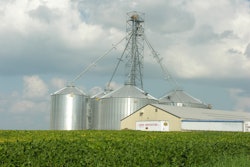充气小麦在储藏箱long been recognized as an integral part of any integrated pest management program — and ultimately, a good grain quality control measure. This is especially important in South Central states such as Kansas, Oklahoma, Texas, Nebraska, New Mexico and Colorado, where warm summer weather heats up the grain’s surface, creating an inviting den for insects and other pests.
Pressure aeration — using fans to push ambient air from the bottom of the bin upwards — has traditionally been the method used by elevators and other wheat handlers. But researchers from the USDA Agricultural Research Service (ARS), located at Kansas State University in Manhattan, KS, set out to determine whether suction aeration would be more effective at managing insects in stored wheat. Suction aeration involves reversing the fans to pull air from the top downward to keep the grain at 60 F or below, the optimal temperature for pest control.
Conclusions from two ARS field trials, conducted by research entomologist Frank Arthur and agricultural engineer Mark Casada, were that suction aeration cools the grain mass more quickly — specifically at the top — than pressure aeration. Despite having the research to back the findings, the news may be hard to swallow for some who have been using pressure aeration for decades.
“There is a stigma about suction aeration,” Casada says. “I’ve heard people say that up North, suction aeration in the winter can pull the bin roof inward if the aeration vents are frozen over. However, if you follow the design criteria for the size of the vent, there should not be a problem.”
Structural damage concerns aside, there is the fear that suction aeration will pull moist air from the headspace down throughout the bin, thus increasing the moisture content of the grain.
Arthur says this was not true in either of their field trials, and states that for South Central U.S. wheat handlers, suction aeration should become the standard technique.
ARS field trials
The researchers conducted their first field trail from July 2004 through March 2005 and the second from July 2006 through March 2007. They used six 1,250-bushel capacity metal storage bins filled with wheat. Three bins were randomly assigned to pressure aeration and three were assigned to suction aeration.
Aeration was accomplished at an approximate airflow rate of 0.22 to 0.31 m3/min/t and was done by adjusting thermostatic controllers to operate the aeration fans when ambient temperatures fell below specified thresholds.
They monitored the temperature of the grain throughout the bin using cables inserted at depths of 1, 3, and 6 feet from the top surface in the center, north and south positions.
Using standard plastic pitfall traps, they sampled seven insect species populations including rusty grain beetles, foreign grain beetles, hairy fungus beetles, red flour beetles, saw-toothed grain beetles, rice weevils and lesser grain borers.
Suction aeration prevails
The data showed that, during the summer, suction aeration cooled the surface zone — the upper portion of the bin — more quickly than pressure aeration did. Cooling the top portion of the wheat is essential in controlling insects because that is where they enter the bin.
So why is suction aeration more effective at cooling the surface zone?
“When the cool air from outside is pulled in and mixes with the warm headspace air, the warm air will expand and the cool air will be pulled down through the grain mass, thereby cooling the surface off much more quickly than could be achieved by pressure aeration,” Arthur explains.
Cooling the surface zone with pressure aeration can take nearly 200 hours, and by then an infestation is likely to be underway.
“With pressure aeration, you cool the bottom of the grain first,” Casada remarks. “You have to wait for that cold front to move up while the top stays warm, and it typically takes 200 hours of fan run time for that to happen. Now, you still want to cool the bottom of the grain, but the advantage of cooling the top first is that’s where the largest insect problem is. Starting at the top gives you a big advantage over the insects.”
Implications for pest management
Arthur said they anticipated the top of the grain mass would cool more quickly with suction aeration, but they were surprised at how much of a temperature difference there was and how immediate the response was from the insects.
For example, in the 2004 trial they found 3,290 rusty grain beetles and 8,210 red flour beetles in pressure aeration-cooled bins vs. 662 and 722 respectively in suction aeration-treated bins.
虽然结果足以让the case for suction aeration, it was not the better method 100% of the time. Some insect species, such as the foreign grain beetle and the hairy fungus beetle, were better controlled by pressure aeration. These findings were more prominent in the second trial that began in 2006.
“The inconsistencies could be due to the rate of cooling, the extent of the infestation when the cooling process began or the fact that different species of insects have different temperature ranges for optimum growth,” says Arthur. “But all the major species that are known wheat pests consistently showed lower populations with the suction aeration. The ones that showed lower with pressure aeration were mainly fungus feeders, which are more incidental pests, and not considered to be a major problem.”
Larger-scale studies are needed, but Arthur and Casada are confident that using suction aeration could reduce the need for fumigant phosphine to control insects in stored wheat.
“If we can lower the insect population through aeration, we might be able to avoid some fumigation,” says Arthur. “We might not be able to avoid it all of the time, and one thing to consider is we still need to evaluate this technique in larger bulk storage. There may be differences when applying this to a 20,000-bushel bin.”
New field trial
Based on the positive results of the first two studies, a larger scale field trial is being conducted at the ARS in Manhattan, KS. Last summer, Arthur and Casada began a three-year trial, monitoring insect pests at 12 different points in two 4,000-bushel wheat bins — one using suction aeration and one using pressure aeration.
In this trial, they are gathering more temperature measurements along the grain’s surface in the headspace of the bin and at the initial surface zone in the grain mass in order to reveal more refined temperature patterns in the two bins.
Since the research will be going on over three years, Arthur and Casada are hoping to get a better handle on the year to year temperature variation factor and its impact on pest management.
Not a catch-all
The advantages of using suction aeration for stored wheat in the South Central United States are clear, but it does not mean that suction aeration is better for all commodities in all regions.
Wheat is harvested and stored over a wide geographical area in the United States, so Arthur cautions that what they’ve found in Kansas may not be true in Northern states.
“The farther north you go, the later in the summer the wheat is harvested and stored,” says Arthur. “We think the general principles would apply — the quicker you cool off the grain surface, the better the insect control — but testing is required to be certain.”
Casada adds that suction aeration is not ideal under certain circumstances. “If you’re drying grain and then loading it warm on top of other grain, then you can’t use suction aeration because you would pull warm air down through the grain that has already been cooled,” he says. “That is very common in grain elevators.”
The effectiveness of suction aeration is also questionable pertaining to soybeans, corn and other fall-harvested crops. The major difference is that in much of the United States, temperatures are already cool enough by harvest time to limit insect populations.
“Wheat has different storage considerations than most fall- harvested crops,” says Casada.”It inherently has more insect problems because it’s put in bins in warm weather. It’s quite difficult to aerate wheat to the right temperature when there are only a few cool hours in the night, so being able to modify a technique that’s already in use to increase its efficacy is quite helpful.”
Under the right circumstances, using suction aeration may be the difference between high quality grain and rejected grain. Over the years, the method has undeservingly made a bad name for itself, but research clearly shows that when done with properly designed equipment, it is far more effective at minimizing pest in wheat than the standard pressure aeration technique.





















